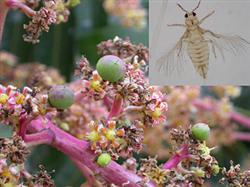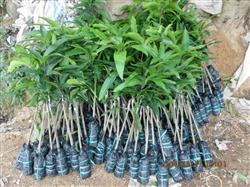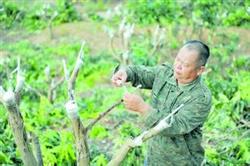Control techniques of diseases and insect pests at flowering and panicle stage of mango

After the mango ear was damaged by diseases and insect pests, the flower ear was deformed, the flower quality decreased, the flower bud fell off, the flower withered, and could not blossom and bear fruit. The prevention and control methods of diseases and insect pests that harm the mango ear are as follows: first, anthrax is the most serious disease that harms the flower ear, which occurs as soon as the flower ear is pulled out, first, black spots appear on the pedicel, and then expand into black spots, and cover all parts of the flower spike, so that the buds die, and a large number of buds fall. There are many Rain Water in spring, when the humidity is high, the disease is serious and spreads rapidly. if it is not prevented in time, the young fruit will be affected. When the flower ear is just sprouting, it should be foliar sprayed with 0.8% Baumetulite sulfur mixture aqueous solution, or 1 ∶ 1 ∶ equivalent Bordeaux solution. After the flower ear is drawn, continuously spray 800 times of Spock solution, or 600 times of green milk copper solution, or 800 times of Baogong solution, etc., spray once every 7 to 10 days, evenly spray all leaves and spikes, it is appropriate to start to drip down, that is, the occurrence of mango anthracnose can be controlled. 2. Soot disease Mango soot disease is mainly caused by scale insects, aphids, flat-beaked leafhoppers, white moth wax cicadas and other prickly mouthparts pests. At first, sticky liquid appears on the spike and the leaves at the base of the spike, and then it is covered with soot, which affects photosynthesis, weakens the spike and is easy to cause falling flowers. For the prevention and control of soot disease, in addition to timely control of the above piercing and sucking mouthparts pests, when there is viscous soot, it is necessary to continuously spray 800-fold methyl thiophanate aqueous solution, or 600-fold ethyl phosphorus-aluminum-manganese-zinc aqueous solution, or 800-fold carbendazim aqueous solution, etc. spray once every 10 to 15 days, the soot will be quickly removed. Third, the scale insects that harm the mango flower ear are mainly cotton blowing scale insects, which cluster on the flower ear and the leaves at the base of the flower ear, prick and suck juice, cause wounds, weaken the growth potential of the flower ear, make the flower ear deformed, and induce soot disease, if it is not prevented in time, it will also make the young fruit black and form spotted fruit. After the flower ear is extracted, you must pay attention to check the leaf and ear, and find that there is a white cotton-like substance, or the flower ear and leaf are covered with sticky coal smoke, and there are scale insects adsorbed, you should spray 1500 times scale dead water solution continuously for 2 times 3 times, or 1000 times with killing water solution, or 1000 times faster scale water solution, etc., spray once every 7 days and 10 days, pay attention to wet flower ear and leaf base. Fourth, powdery mildew appears on the pedicel of the spike when the spike is just coming out, and then expands to form a layer of white powdery substance. The flower stops blooming after it is infected, then falls off, and the inflorescence turns black. When small powdery plaques appear on the flower spike, the aqueous solution of 600x sulfur suspension, 800x strychnine aqueous solution or 1000 times trimethoprazole aqueous solution should be sprayed continuously for 3 times, once every 7 to 10 days. 5. Aphids, thrips, flat-beaked leafhoppers and white moth wax cicadas are all stabbing and sucking juice on the flower spike, causing soot disease, weakening the flower ear and affecting blossom and fruit. during the growth and development of the flower ear, the mixture of 1000-fold trichlorfon or 1000-fold dichlorvos and 1000-fold trichlorfon must be sprayed continuously for control. Spray once when the spike grows to 5 cm, 15 cm, 20 cm and 25 cm respectively. Spodoptera litura, Spodoptera litura, Spodoptera litura and Spodoptera litura are flower-eating pests. After the flower ear is pulled out, it is harmful from the middle of the pedicel, causing the flower ear to dry up. Beetles and poisonous moths mainly bite flower spikes, forming bald spikes, unable to blossom and set fruit. The control of the above-mentioned pests is mainly timely spraying during the growth and development of flower spikes. generally, when the flower spike is just sprouting, the length of the flower ear is 15 cm 20 cm and the flower ear length is 25 cm 30 cm, each spray 2500 times the enemy killing aqueous solution, or 2500 times an Lubao aqueous solution.
- Prev

Cultivation techniques of Ganoderma lucidum with mango sawdust
1. Scion selection: the scion is collected from the improved variety mother garden or adult mother tree. The mother plant requires pure variety, high yield, stable yield, high quality and no quarantine diseases and insect pests. All nurseries with suitable conditions should have ear picking nurseries, which are specially used for ear picking and ear grafting. Select branches for the crown periphery to the sun, strong growth, full buds, disease-free.
- Next

High grafting and replacement method of mango
First, before preparing to change the species, it is necessary to strengthen the fertilizer and water management of the changed trees. Prune the aboveground parts properly and remove diseased, withered, shady and overdense branches. Cross branches should be cut off; for perennial trees, the main and side branches should be sawed off at 1.2-1.5 meters above the ground in spring and autumn (spring and autumn grafting, autumn saw grafting in the next spring).
Related
- Moge, come on! The staff of the peasant association in the producing area of cantaloupe were frightened when the crowd gathered.
- Causes and Solutions of low Fruit setting rate of Apple
- Symptoms and control measures of passion fruit virus disease
- Fruit growing lesson: how do apple orchards keep high yields?
- Can you build orchards in the mountains? What are the pros and cons?
- How to manage the coloring period of Crisson grape?
- This paper introduces the processing technology of two kinds of fig products.
- How much is a month for retired teachers in rural areas by 2020?
- How can strawberry planting increase sugar content? We should pay attention to management in many aspects.
- What are the cultivation techniques on how to improve the yield of golden fruit?

